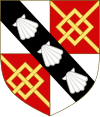Earl of Sunderland
| Earldom of Sunderland | |
|---|---|

|
|
| Creation date | 1627 |
| Monarch | Charles I |
| Peerage | Peerage of England |
| First holder | Emanuel Scrope, 12th Baron Scrope of Bolton |
| Present holder | Jamie Spencer-Churchill, 12th Duke of Marlborough |
| Heir apparent | George Spencer-Churchill (he used this title as a courtesy title) |
Earl of Sunderland is a title that has been created twice in the Peerage of England. The first creation came in 1627 in favour of Emanuel Scrope, 12th Baron Scrope of Bolton. The earldom became extinct on his death in 1630 while the barony became either extinct or dormant (see Baron Scrope of Bolton for more information on this title). The second creation came in 1643 in favour of the Royalist soldier Henry Spencer, 3rd Baron Spencer of Wormleighton. The Spencer family descended from Sir John Spencer (d. 1522) who acquired the Wormleighton estate in Warwickshire and the Althorp estate in Northamptonshire. His grandson Sir John Spencer (d. 1586) was a Knight of the Shire for Northamptonshire. The latter's grandson Sir Robert Spencer represented Brackley in Parliament in the late 16th century. In 1603 Sir Robert was raised to the Peerage of England as Baron Spencer of Wormleighton. He was succeeded by his eldest surviving son, William, the second Baron. He had previously represented Northamptonshire in Parliament. His eldest son was the aforementioned third Baron. In July 1643 he was created Earl of Sunderland in the Peerage of England. Lord Sunderland was killed at the Battle of Newbury in September of the same year. He was succeeded by his two-year-old only son, Robert, the second Earl. He later gained great distinction as a statesman and notably served four times as Secretary of State for the Southern Department.
...
Wikipedia

